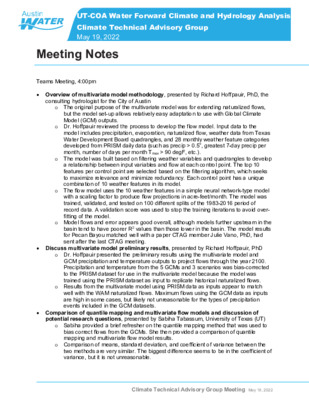May 19, 2022 CTAG meeting notes — original pdf
Backup

UT-COA Water Forward Climate and Hydrology Analysis Climate Technical Advisory Group May 19, 2022 Meeting Notes Teams Meeting, 4:00pm Overview of multivariate model methodology, presented by Richard Hoffpauir, PhD, the consulting hydrologist for the City of Austin o The original purpose of the multivariate model was for extending naturalized flows, but the model set-up allows relatively easy adaptation to use with Global Climate Model (GCM) outputs. o Dr. Hoffpauir reviewed the process to develop the flow model. Input data to the model includes precipitation, evaporation, naturalized flow, weather data from Texas Water Development Board quadrangles, and 28 monthly weather feature categories developed from PRISM daily data (such as precip > 0.5”, greatest 7-day precip per month, number of days per month Tmax > 90 degF, etc.). o The model was built based on filtering weather variables and quadrangles to develop a relationship between input variables and flow at each control point. The top 10 features per control point are selected based on the filtering algorithm, which seeks to maximize relevance and minimize redundancy. Each control point has a unique combination of 10 weather features in its model. o The flow model uses the 10 weather features in a simple neural network-type model with a scaling factor to produce flow projections in acre-feet/month. The model was trained, validated, and tested on 100 different splits of the 1983-2016 period of record data. A validation score was used to stop the training iterations to avoid over- fitting of the model. o Model flows and error appears good overall, although models further upstream in the basin tend to have poorer R2 values than those lower in the basin. The model results for Pecan Bayou matched well with a paper CTAG member Julie Vano, PhD, had sent after the last CTAG meeting. Discuss multivariate model preliminary results, presented by Richard Hoffpauir, PhD o Dr. Hoffpauir presented the preliminary results using the multivariate model and GCM precipitation and temperature outputs to project flows through the year 2100. Precipitation and temperature from the 5 GCMs and 3 scenarios was bias-corrected to the PRISM dataset for use in the multivariate model because the model was trained using the PRISM dataset as input to replicate historical naturalized flows. o Results from the multivariate model using PRISM data as inputs appear to match well with the WAM naturalized flows. Maximum flows using the GCM data as inputs are high in some cases, but likely not unreasonable for the types of precipitation events included in the GCM datasets. Comparison of quantile mapping and multivariate flow models and discussion of potential research questions, presented by Sabiha Tabassum, University of Texas (UT) o Sabiha provided a brief refresher on the quantile mapping method that was used to bias correct flows from the GCMs. She then provided a comparison of quantile mapping and multivariate flow model results. o Comparison of means, standard deviation, and coefficient of variance between the two methods are very similar. The biggest difference seems to be in the coefficient of variance, but it is not unreasonable. Climate Technical Advisory Group Meeting May 19, 2022 UT-COA Water Forward Climate and Hydrology Analysis Climate Technical Advisory Group May 19, 2022 Meeting Notes o When comparing methods across time horizons, the pattern is the same although the magnitude of flows differs somewhat. Comparison of maximum flows shows a similar relationship across time horizons. o CTAG member and Texas State Climatologist John Nielsen-Gammon, PhD, noted that the multivariate model was using temperature as the first variable as a proxy for seasonality. Dependence on that variable may be incorrect in the future given that climate is changing and this could affect the average trend over several decades. The CTAG discussed various methods to address this concern. o Several members of the CTAG felt reassured that the two methodologies produced similar results. It was noted that it would be important to look at signals from the models pre-bias correction as well as performing sensitivity analyses. The Austin Water project team noted that they plan to conduct a sensitivity analysis. Dr. Hoffpauir shared slides for temperature and precipitation that showed pre- and post- bias corrected data trends. o The UT team lead, Liang Yang, PhD, noted that the maximum flows differ between methods. Higher flows tend to occur in the quantile mapping method. A future research question could be to look into these differences and maximum flow trends. The CTAG recommend looking into raw precipitation values (including anomalies) from GCMs to investigate this phenomenon. From a water resources perspective, the volume and distribution of precipitation can be very important. o Dr. Vano expressed that she was more comfortable using the multivariate method rather than direct GCM outputs. o Austin Water will be moving forward with the multivariate method for developing Water Forward flows and will continue to research quantile mapping as a possible method for future updates and research questions. Other items and adjourn o The meeting was concluded at 5pm. Climate Technical Advisory Group Meeting May 19, 2022